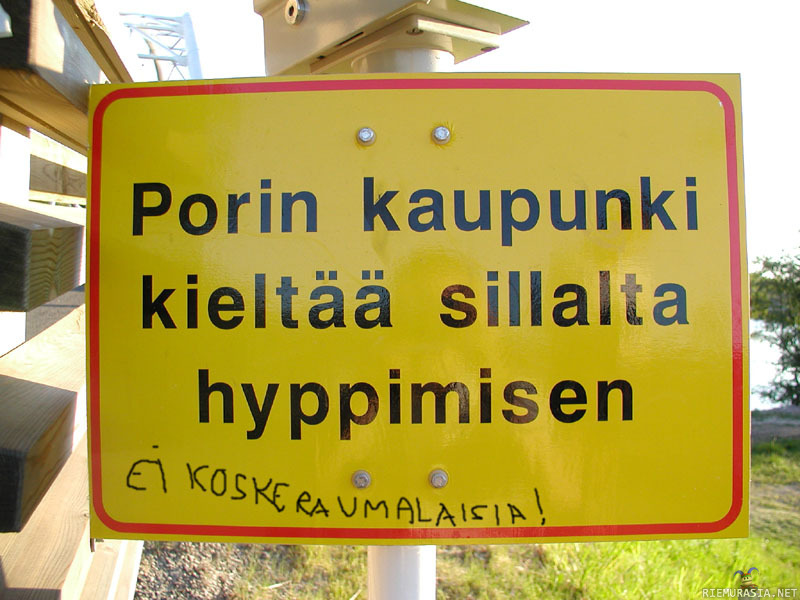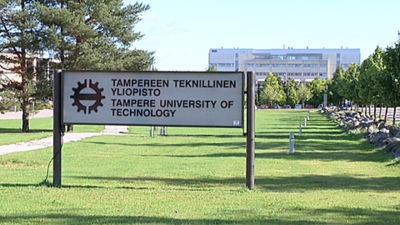Olen Teemo Tebest, tämän datajournalismiblogin kirjoittaja (Kuva 1). Tämä kirjoitus kertoo miten minusta tuli ammattillinen minä ja mitä seuraavaksi.
 |
| Minä jalkapallon EM-kisojen studiossa Pasilassa 2018. (Kuva 1) |
Aloitin yliopisto-opintoni vuonna 2003. Minut valittiin Tampereen teknillisen yliopiston Porin yksikköön opiskelemaan tietotekniikkaa (Kuva 2). Yliopistomaailma ja sen vaatimukset olivat minulle melko suuri harppaus lukiosta.
 |
| Porissa opiskelijaelämä oli hyvin vähäistä ainakin Yliopistokeskuksella. (Kuva 2) |
Ensimmäinen puoli vuotta ennen armeijaa menikin lähinnä katsellessa. Syksyllä 2004 aloitin ensimmäisen kokonaisen lukukauteni. Tavoitteeni ja motivaationi armeijan jälkeen oli opiskella niin ahkerasti, että pääsisin vaihtamaan opinto-oikeuteni Porista Tampereelle. Poriin en halunnut jäädä.
Porista Tampereelle
Pääsin lopulta Tampereelle sekä sisäisellä siirrolla hyvän opintomenestyksen ansiosta kuin pääsykokeidenkin kautta lukukauden 2005 alusta (Kuva 3). Ensimmäiset vuodet Tampereella olivat rankkoja. Uskon, että monille perusopinnot tuottavat tuskaa ja niin myös minulle. Etenkin, kun opintoihin liittyivät myös maisemanvaihdos ja yleisesti aikuistuminen.
 |
| TTY:n etunurmi oli monien hauskojen muistojen tapahtumapaikka. (Kuva 3) |
Muistan, että matematiikan ja fysiikan kursseja oli todella paljon, ja asiat olivat vaikeita. Myöskään ensimmäiset koodauskurssit eivät tuntuneet omilta. C++ ei ollut sellainen kieli, joka minulle olisi tullut luontevana. Vähitellen tuohon kaikkeen toki orientoitui ja aloin luottaa, että kun asioihin satsaa, niistä myös selviytyy.
Vuoden 2007 aikoihin löysin Hypermedialaboratorion tarjoamat kurssit. Niissä opiskeltiin web-teknologioita kuten Javascriptiä, PHP:tä, XML:ää ja HTML:ää sekä käytettävyyttä ja verkkopalvelujen suunnittelua. Nämä tuntuivat mielekkäiltä, vaikka opiskelukaverit pitivätkin näitä kursseja lähinnä "käsienheilutteluna". (Kuva 4)
 |
| Web-teknologiat eivät olleet vielä yliopistoaikanani koulutuksessa suuressa arvossa. (Kuva 4) |
Vuodesta 2007 lähtien opiskelin todella aktiivisesti erilaisten web-teknologioiden käyttöä. Tuolloin perustin myös Statster-nimisen verkkopalvelun, jonka kautta koodaamisesta ja sen opettelusta tuli minulle myös harrastus, jossa tunteja ei laskettu. Vuosina 2007 ja 2008 opin koodaamaan. Pääosin tein PHP:ta ja Javascriptiä.
Opinnoista työelämään
Loppuvuonna 2008
Jukka Huhtamäki vinkkasi minulle, että Hypermedialaboratoriossa olisi tutkimusapulaisen paikka auki. En ollut ikinä tehnyt oman alani töitä ja nyt siihen tarjoutui mahdollisuus. Hain paikkaa – ja sain sen. Tuo oli minulle erittäin suuri suuri askel. Lopulta tein töitä tutkimusapulaisena ja tutkijana töitä yhteensä kolme vuotta vuodesta 2009 vuoden 2011 loppuun. Olen tästä mahdollisuudesta todella kiitollinen Jukalle ja koko porukalle siellä. Hypermedialaboratorio oli erinomainen paikka kasvaa ja kehittyä koodaajana sekä opetella informaation visualisointia.
Tutkin siis yliopistolla informaation visualisointia ja tein jatko-opintoja sekä tutkimuspapereita. Tutkijan työ ei kuitenkaan tuntunut täysin omalta. En tiennyt vielä silloin, mikä minua todella kiinnosti, vaan olin enemmän “vain töissä”. En kokenut kutsumusta, ja tutkijan työn prosessien verkkaisuus ei motivoinut minua oikealla tavalla.
Olin kuullut datajournalismista, joka oli tuolloin 2010–2011 nouseva termi Suomessa. Erilaiset yksittäiset tapahtumat, kuten Tampereella järjestetty Datajournalismin päivä, HSOpen-tapahtumat ja se, että loppuvuonna 2011 perustin tämän blogin, ohjasivat minua alitajuntaisesti siihen, että kun näin, että Ylelle haetaan tekijää ajattelin, että se voisi olla mielenkiintoinen paikka.
Yliopistolta Svenska Ylelle
Svenska Ylen työpaikkailmoitus tuli eteeni siis syksyllä 2011, ja edellä mainituista syistä päädyin hakemaan tuota web-kehittäjän työtä. Muistan, miten ajoin junalla Tampereelta Helsinkiin ja ensimmäistä kertaa astelin Ylelle - ja etenkin sen hetken, kun astelin haastattelusta pois. Päällimmäiseksi jäi tunne, että tänne haluan. (Kuva 5)
 |
| Yle ei opintojen aikana ikinä tullut mieleen paikkana, jossa voisin olla töissä. (Kuva 5) |
Sainkin paikan web-kehittäjänä, pitkälti Drupal-osaamiseni vuoksi. Drupal-osaajia ei tuolloin juuri ollut saatavilla, joten tällainen keskinkertaisempikin Drupal-koodari kelpasi. Drupalia olin opetellut ja tehnyt yliopistolla tutkimustyön ohella. Aivan mahtavaa Svenska Yle, että otitte minut tiimiin. Kiitos
Kristoffer Söderlund ja
Sami Kallinen. Tuolloin muutto Tampereelta Helsinkiin oli toisaalta todella iso askel, mutta toisaalta hyvin luonteva siihen elämäntilanteeseen.
Svenska Yleltä Plus-deskiin
Vuoden 2012 lopulla Yleen oltiin perustamassa Plus-deski -nimistä tiimiä, jonne etsittiin yhtä koodaustaitoista toimittajaa, ja hain tätä paikkaa. Olin vuoden 2012 aikana tehnyt myös journalistisia projekteja web-kehittäjän työni lomassa. Tein esimerkiksi vaalianalyysejä, tutkin perussuomalaisten äärikytköksiä ja visualisoin alkoholin myyntitietoja. Näitä juttuja julkaistiin niin täällä blogissani, kuin Svenska Ylen ja Yle Uutisten sivuilla.
Datajournalismi ja journalismi yleisesti tuntuivat todella mielenkiintoiselta haasteelta. Olin todella innoissani, kun sain tehdä projekteja toimittajien kanssa. Vaikka en ollut koskaan ajatellut, että minusta tulisi toimittaja, niin työnä se kiehtoi. Pääsin tekemään asioita, joiden kuluttaja olin ollut. Ja kerrankin tein työtä, jonka pystyisin selittämään äidille. Työn nopeatempoisuus ja työskentely muiden kuin teknisten ihmisten kanssa olivat varmasti myös selittäviä tekijöitä sille, miksi journalismi kiehtoi.
Minut valittiin tuohon mainittuun koodaavan toimittajan tehtävään Plus-deskiin (Kuva 6). Hyppäys Svenska Yleltä Yle Uutisten puolelle oli aikanaan iso ja vaikea päätös, koska Svenska Ylellä asiat toimivat ketterästi ja valtava Yle Uutisten koneisto vaikutti ulkoapäin jähmeältä. Etenkin kun samaan aikaan Svenska Ylelle oltiin myös perustamassa datajournalistista tiimiä, johon minut haluttiin.
Mika Rahkonen sai kuitenkin vakuutettua minut ottamaan paikan Plus-deskissä vastaan. Muistan elävästi, kun kysyin häneltä lounastapaamisessa: "Onko ongelma, etten ole oikein hyvä auktoriteettien kanssa". En muista mitä Mika vastasi, mutta vastaus miellytti, ja suurempi vastuu ja isommat piirit kuitenkin kiinnostivat.
 |
| Plus-tiimi joulukuussa 2016. Vasemmalta: Juho Salminen, Eemeli Martti, Stina Tuominen, Juha Rissanen, Teemo Tebest, Mika Pippuri, Anna Hurtta ja Ville Juutilainen. (Kuva 6) |
Tiedostan, että urallani on ollut henkilöitä, jotka ovat tukeneet ja uskoneet minuun oikeilla hetkillä. Tämä on ollut todella arvokasta. Ja näitä henkilöitä on myös paljon mainittujen lisäksi.
Plus-deskissä kasvoin ammattilaiseksi omassa työssäni
Vuodesta 2013 olen siis työskennellyt täysipäiväisesti datajournalistina ja toimittajana Ylen Plus-deskissä. Työssäni olen tehnyt Suomen suosituimpia verkkosisältöjä yhdessä tiimin ja muiden toimitusten kanssa. Tämä aika on ollut erittäin (erittäin) mielenkiintoista ja palkitsevaa. Olen saanut tehdä journalismia ja sisältöjä todella osaavien ja asiantuntevien tyyppien kanssa.
Näinä reiluna kuutena vuotena minusta on tullut myös erittäin kysytty puhuja kouluihin ja konferensseihin. Olen kiertänyt puhumassa Suomessa lukuisissa paikoissa, niin yliopistoissa kuin korkeakouluissa sekä seminaareissa ja tapahtumissa. Lista maista, joissa olen lisäksi käynyt on venähtänyt jo mukavaksi: Norja, useamman kerran Ruotsissa, Tanska, kahdesti Virossa, USA, Englanti, Italia ja pari kertaa Sveitsissä. Kattoteema näillä keikoilla on ollut aina sama – datajournalismi. (Kuva 7)
 |
| Esiinnyin Tallinnan musiikkiviikkojen yhteydessä pidetyssä tapahtumassa keväällä 2018. (Kuva 7) |
Kiitos Hypermedialaboratorio ja tyypit siellä. Kiitos Svenska Yle, että otitte minut aikanaan Ylelle. Ja kiitos osallisille Yle Uutisissa, että palkkasitte minut Plus-deskiin. Kiitos koko Plus-deskin väki ja kaikki te, joiden kanssa olen saanut tehdä töitä. Te kaikki olette tehneet minusta ammattilaisen alallani!
Ja vaikka ovi ei Ylelle sulkeudu lopullisesti, nyt on aika siirtyä eteenpäin ja hakea uutta haastetta. Tähän minulle tarjoutui oiva mahdollisuus, sillä…
 |
| Alpit mielessäin. (Kuva 8) |
Lähden datajournalistiksi EBU:uun, Geneveen
Edessä on siis muutto Sveitsiin, Alppien juurelle. (Kuva 8)
Tuleva työtehtäväni on uusi ja sen tarkoituksena on viedä yleisradioyhtiöiden datajournalismia ja -osaamista kokonaan uudelle tasolle. Tehtävässäni koulutan ja vien datajournalistista osaamista eteenpäin Euroopassa. Käytännössä tämä tarkoittaa datajournalistisen osaamisen viemistä ruohonjuuritasolle EBU:n jäsenorganisaatioissa ja tarkoituksena on myös tiivistää organisaatioiden välistä yhteistyötä. Lisäksi tavoitteena on tuottaa datajournalistisia juttuja jäsenorganisaatioiden käyttöön.
Haaste on iso, mutta olen siitä todella innoissani (kuva 9) ja pyrin kirjoittamaan kuulumisia tänne blogiin.
 |
| Party On! (Kuva 9) |












